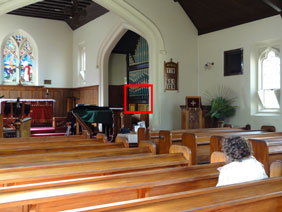Canon PowerShot SX210 IS
-
-
Written by Gordon Laing
Canon PowerShot SX210 IS vs Sony Cyber-shot DSC-HX5 High ISO Noise (default auto settings)
Canon PowerShot SX210 IS results : Real-life resolution / Sharpness wide-angle / Sharpness telephoto / High ISO Noise
Canon PowerShot SX210 IS results : Real-life resolution / Sharpness wide-angle / Sharpness telephoto / High ISO Noise
|
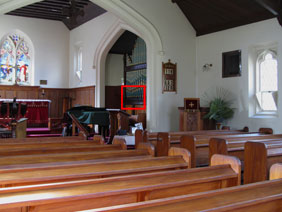 |
To compare noise levels under real-life conditions we shot this scene with the Canon PowerShot SX210 IS and Sony Cyber-shot DSC-HX5 within a few moments of each other using their best-quality JPEG settings and at each of their ISO settings. The lenses on each camera were adjusted to deliver the same field-of-view; the Sony crops are larger due to its lower resolution. Each camera was set to Program mode without intervention to see how they performed with default settings. |
The image above was taken with the Canon PowerShot SX210 IS in Program mode at 80 ISO with an exposure of 0.5 seconds and the lens set to 8mm f3.5; the original file measured 2.93MB. The crops below are taken from the area marked with the red rectangle and presented here at 100%. The crops from the Sony HX5 show a larger area due to its lower resolution. You may wish to also open the equivalent page from our Panasonic TZ10 / ZS7 review for comparison, although bear in mind the results on that page and this page were taken on different days.
Note: the Sony Cyber-shot HX5 (and its touch-screen partner, the TX7) additionally offer two modes specifically designed for use in low light: Handheld Twilight (HHT) and Anti Motion Blur (AMB). Both modes fire-off six frames in quick succession and stack them to generate a single image with better protection against noise and camera-shake respectively. In the first series of images below, we’ve set the Sony HX5 to Program and manually selected steadily increasing sensitivities as we would normally do in our High ISO Noise tests, but below these you’ll find additional samples taken moments later using HHT and AMB. Neither mode allows you to manually set the sensitivity, so we’ve been forced to use the automatic settings for each: under these conditions, HHT and AMB selected sensitivities of 400 and 3200 ISO respectively. Click here to jump straight to these results.
But back to our standard sequence in Program mode. The SX210 IS kicks-off the series below at 80 ISO where it delivers a crisp, detailed result, albeit one where pixel-peepers will already notice a little background texture from noise; interestingly, Panasonic’s TZ10 / ZS7 appears cleaner at 80 ISO.
In the second row we have the SX210 IS increased by a small degree to 100 ISO, alongside the Sony Cyber-shot DSC-HX5 using its lowest sensitivity of 125 ISO. Beyond the difference in cropped area (due to their respective resolutions), there’s a noticeable difference in image processing strategies. The Canon opts for a relatively hands-off approach with greater visible noise compared to the over-zealous processing of the Sony which eliminates most noise textures, but at the cost of smearing-out the finest details. As such, the Canon SX210 IS sample on this row contains finer details, but with noise textures which have already become quite apparent. Once again the Panasonic TZ10 / ZS7 at 100 ISO is managing a good balance between applying sufficient noise reduction to eliminate the speckles without losing too much detail.
At 200 ISO the Canon SX210 IS image has become a little softer, losing the crisp edges of the earlier samples. Visible noise remains at a similar level, but there’s definitely more processing taking place behind the scenes. The Sony HX5 and Panasonic TZ10 / ZS7 samples at 200 ISO also show a slight softening with a minor increase in artefacts.
With the sensitivity increased to 400 ISO, the Canon image has become quite noisy, losing much of the finest details. The Panasonic TZ10 / ZS7 has also become quite patchy at this point, and while its punchier processing delivers a more contrasty image, there’s not actually any perceptible advantage in terms of real-life detail over the Canon. In the meantime, Sony is still keeping visible noise at bay on the HX5 for a cleaner-looking result, but one that’s gradually losing saturation and fine detail. Note, below the main sequence you’ll find additional comparisons showing the Sony HX5’s Handheld Twilight mode, which under these conditions automatically selected a sensitivity of 400 ISO – you can see if it does a better job than the normal Program setting at 400 ISO later.
Returning to the main sequence at 800 ISO, the Canon SX210 IS suffers from a noticeable reduction in saturation along with a hike in visible noise, for a softer image that’s lost most of its fine detail. The Sony HX5 sample at 800 ISO is looking pretty splotchy at this point, but it’s arguably a little preferable to the Canon. Looking back at our results for the Panasonic TZ10 / ZS7, it too is suffering from a significant increase in artefacts at 800 ISO, and again while the punchy processing is counteracting much of the traditional saturation-loss, there’s not a great deal of fine detail remaining. That said, it’s preferred to the Canon result.
At 1600 ISO, all three cameras are unsurprisingly struggling. The Canon SX210 IS has become very soft and noisy, with the fine detail now long gone. The Panasonic TZ10 / ZS7 has arguably taken the biggest hit of all with a very patchy result with a swing in colour balance. The Sony HX5 is no angel at this point either, but it’s arguably the best of the three.
At this point, both the Canon SX210 IS and Panasonic TZ10 / ZS7 switch to their Low Light and High Sensitivity presets respectively, both operating at significantly reduced resolutions at with automatic sensitivities up to 3200 ISO. Under the conditions of the day, the SX210 IS selected 1600 ISO, and the drop in resolution certainly makes it look better than the full-sized version above, but remember you may achieve a similar result by just reducing the size of the big file. Panasonic’s High Sensitivity preset at 3200 ISO looks crisper than the Canon, but again this is mostly the application of greater contrast and sharpening for a punchier result. In the meantime, the Sony HX5 is the only one of the three to bravely capture a full-sized image at 3200 ISO, although it’s pretty damaged by noise artefacts at this point.
Ultimately like most compacts, the Canon SX210 IS performs at its best at 200 ISO or below, but even at the lowest sensitivity of 80 ISO, you’ll see some visible noise textures. Look closely and you’ll see a small benefit in resolved detail at these lowest ISOs compared to the Sony and Panasonic, but by 400 ISO and above any advantage has gone, and indeed you may prefer the output from the lower resolution models.
As mentioned above, the Sony HX5 additionally offers two modes specifically for use in low light conditions. You’ll find examples of these below our main ISO sequence – click here to jump straight to them. Alternatively head straight over to our Sample Images Gallery for more examples across the Canon’s sensitivity range, or if you’ve seen enough, head on over to our verdict!
Canon PowerShot SX210 IS |
Sony Cyber-shot DSC-HX5 | |
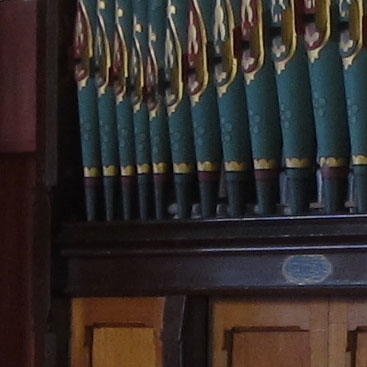 |  | |
80 ISO |
Below 125 ISO not available | |
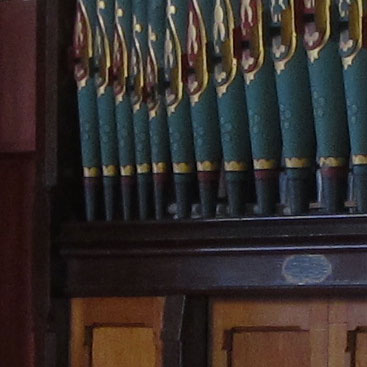 |  | |
100 ISO |
125 ISO | |
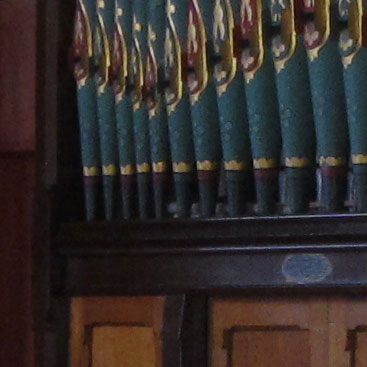 |  | |
200 ISO |
200 ISO | |
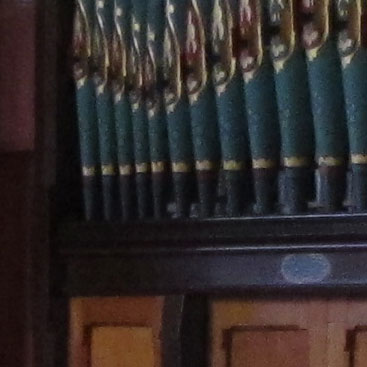 |  | |
400 ISO |
400 ISO | |
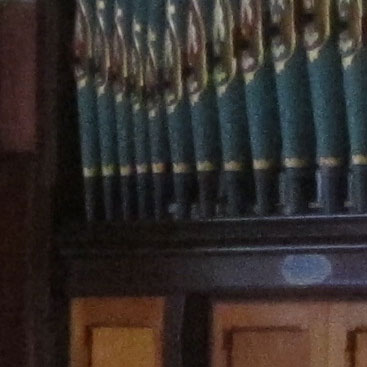 |  | |
800 ISO |
800 ISO | |
 |  | |
1600 ISO |
1600 ISO | |
 |  | |
Low Light preset (here at 1600 ISO) |
3200 ISO |
Sony Cyber-shot DSC-HX5: Handheld Twilight mode versus Program mode (at 400 ISO)
Below right is a 100% crop from the Handheld Twilight sample, which under the conditions of the day automatically selected a sensitivity of 400 ISO. Interestingly the result was darker than the samples shot in Program mode, so we took a second comparative image in Program with -0.3EV compensation, at the same sensitivity of 400 ISO. You can see the crop from this sample below left. While there’s still a small difference in brightness, it’s clear the Handheld Twilight version is cleaner than the one shot in Program. The patchy noise artefacts of the Program version have been greatly reduced, with crisper edges. It’s as if the noise reduction has been increased, but without any negative side-effects. The actual degree of real-life detail is essentially the same, but by delivering a cleaner result without compromise, the Handheld Twilight version is definitely preferred. For good measure we’ve also repeated our 400 ISO Program sample from the SX210 IS below, albeit at the originally metered value. Despite the greater difference in brightness, it’s again clear how the HX5’s Handheld Twilight mode has managed to deliver a similar degree of real-life detail, but without the noise. Again it’s like noise reduction has been applied without any negative consequences. This is a successful result for the Sony HX5, and in similar conditions, we’d definitely recommend using its Handheld Twilight mode over Program or Manual at 400 ISO. It’s a key advantage the Sony has over the competition and we plan to expand our Sony HX5 review to include more examples in the near future. In the meantime, scroll down to see how its second mode, Anti Motion Blur, performs under the same conditions.
|
Sony Cyber-shot DSC-HX5: Anti Motion Blur mode versus Program mode (at 3200 ISO)
Below right is a 100% crop from the Anti Motion Blur sample, which under the conditions of the day automatically selected a sensitivity of 3200 ISO. Unlike the Handheld Twilight mode above, the brightness of the image matched that of our original sequence, so below we’ve pictured crops from the Anti Motion Blur on the right and Program mode manually set to 3200 ISO on the left. As discussed in the main sequence, the 3200 ISO sample in Program mode is very noisy. The crop from the Anti Motion Blur version is also suffering from a lot of noise, but it’s a visible improvement over the Program sample at the same sensitivity. It’s much cleaner and has better-defined edges. If you scroll back up to compare it against the main sequence, it’s fair to say it’s closest to the 1600 ISO sample in Program mode. So in this particular situation, Anti Motion Blur has effectively given us the speed benefit of shooting at 3200 ISO, but with quality roughly similar to 1600 ISO in Program. As such it’s a no-brainer to use it in conditions when you need this top sensitivity. Don’t expect miracles though – the image is still noisy and lacking saturation, and therefore best-suited to very small prints or online reductions, but by delivering a superior result to its rivals (not to mention its own Program mode) at 3200 ISO, it’s a valuable ally to have in emergency situations. So another successful result for the Sony HX5, again illustrating how the company is thinking sensibly about addressing the low light issues which face cameras with small sensors. These modes are a key advantage the Sony has over the competition and we plan to expand our Sony HX5 review to include more examples in the near future. But now it’s back to our Canon PowerShot SX210 IS review, where we’ll take a look at more real-life images across its sensitivity range in our sample images gallery.
|


